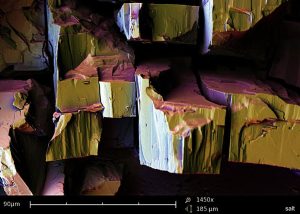Bridging the Gap: Entry-Level SEM by Thermo Scientific via BlueScientific

The Scanning Electron Microscope (SEM) has emerged as a transformative tool, unlocking microscopic mysteries and reshaping our understanding. BlueScientific selected the entry-level SEM from Thermo Scientific as it promises to revolutionise research. Let’s delve into the intricacies of SEM and explore its myriad applications.
What is SEM?
SEM, which stands for Scanning Electron Microscopy, has redefined how researchers examine specimens since its inception in the early 1950s. Unlike traditional microscopes, SEM utilises electrons instead of light to form highly magnified images. This technological shift has significantly broadened the scope of study in medical and physical science communities, allowing for the exploration of a diverse range of specimens.
How SEMs Work
At the heart of SEM operation is an electron gun that produces a focused beam of electrons. Following a vertical path within a vacuum, this beam passes through electromagnetic fields and lenses, eventually reaching the specimen. The interaction between the electron beam and the sample results in the emission of electrons and X-rays. Detectors capture these emissions, converting them into a signal that generates the final image on a screen.
Sample Preparation for SEM
One crucial aspect of SEM is the preparation of samples to suit the vacuum conditions and electron-based imaging. Conductive materials such as metals require no special preparation, while non-metals undergo coating with a thin layer of conductive material using a device called a “sputter coater.” This meticulous preparation ensures optimal imaging conditions and clarity.
Backscattered and Secondary Electrons
Understanding the distinction between backscattered electrons (BSEs) and secondary electrons (SEs) is pivotal in SEM analysis. BSEs, resulting from elastic interactions, provide information about a sample’s composition, while SEs, generated through inelastic interactions, offer detailed surface information. These electrons play a crucial role in diverse analyses.
Advantages of SEM
The SEM boasts numerous advantages over traditional microscopes. With a considerable depth of field and higher resolution, SEM allows more of a specimen to be in focus simultaneously. Using electromagnets instead of lenses provides researchers with greater control over the degree of magnification. These advantages, coupled with strikingly clear images, position SEM as one of the most valuable instruments in research today.
Sample Preparation for SEM
Preparing a sample for SEM involves meticulous steps due to the vacuum conditions and electron-based imaging. All water must be removed from the samples to prevent vaporisation in the vacuum. Conductive materials like metals require no preparation, while non-metals need coating with a thin layer of conductive material using a “sputter coater.”
Types of Analysis by SEM
SEM excels in various types of analysis, including Backscattered Electron Detection (BSE), Energy-Dispersive X-ray Spectroscopy (EDS), Cathodoluminescence (CL), and Electron Backscatter Diffraction (EBSD). These analyses provide valuable insights into composition, crystallography, and morphology, expanding SEM’s applications across diverse industries.
Industries and Sectors Using SEM
The adaptability of SEM makes it indispensable in various scientific, research, industrial, and commercial applications. Industries such as biological sciences, forensics, geological sampling, medical science, electronics, and materials science benefit from SEM’s ability to provide detailed information on topography, composition, and morphology.
In conclusion, the collaboration between Thermo Scientific and BlueScientific brings an entry-level SEM that bridges the gap, making this powerful tool accessible to researchers. The advancement in SEM technology is a testament to the commitment to innovation, promising groundbreaking discoveries across different scientific disciplines.

